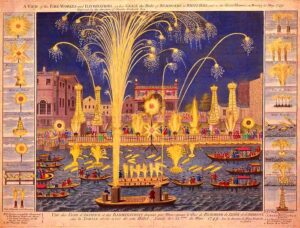Handel, Royal Fireworks

It was 1749 and the king wanted a celebration. George II had signed the Treaty of Aix-La-Chapelle ending the War of the Austrian Succession. Handel (1685-1759) was the logical composer for the occasion. By then he had had a long career in London that included commissions for the coronation of George II in 1722. Handel had composed all of his operas by 1741 and had turned primarily to oratorios. (Messiah premiered in 1742.)
Royal Fireworks is a suite consisting of six movements. This video includes the final movements: Le Rejouissance (rejoicing) and a pair of minuets. Baroque suites typically featured a variety of dance forms—usually an allemande, courante, sarabande, and gigue—but others might appear in addition or instead of those (e.g., gavottes, bourrées, and minuets).
It might have been expected that this event would be much like an earlier celebration on the River Thames in 1717 that was the occasion for Handel’s Water Music, actually a collection of three baroque suites. The event in 1749 did not go so well. Classical FM explains:
Despite the frenzy of preparation, no one had factored in the possibility of bad weather. So naturally it rained, most of the fireworks refused to light, and the few that did light caused the staging to catch fire. There’s no record of what Handel made of it all, although a contemporary, Horace Walpole, reported that the evening was ‘pitiful and ill-conducted’ but ‘very little mischief was done, and but two persons killed’.
King George II had insisted on an ensemble comprised of winds and percussion. Handel later revised the work to include strings.



